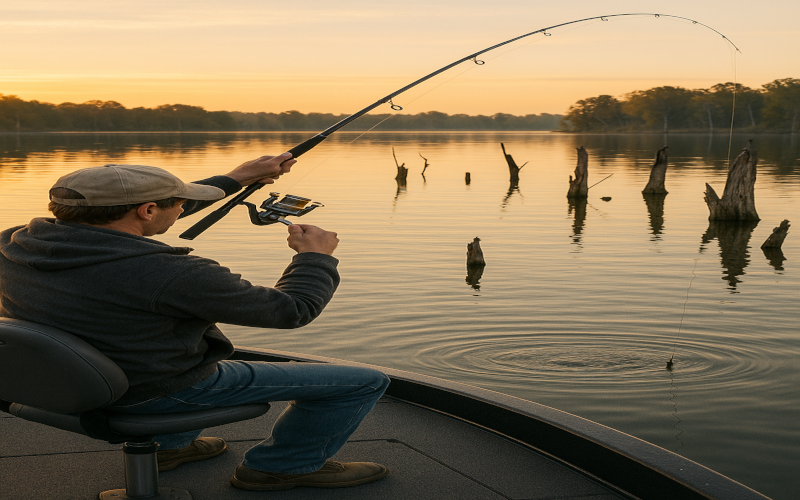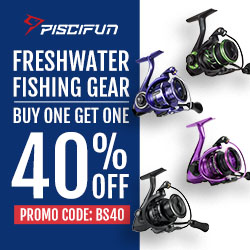Disclaimer: This post may have affiliate links. As an Amazon Associate, I earn from qualifying purchases.
Jigging for Success: The Technique That Turns Ordinary Days Into Trophy Catches
September 23, 2025 - Reading time: 6 minutes
Master jigging techniques that trigger strikes when nothing else works. Learn vertical, swimming, and punch jigging for bass, walleye, and more.

When the bite slows down and other anglers start packing it in, jigging is often the secret weapon that keeps fish hitting. Unlike steady retrieves, jigging mimics a wounded baitfish or crustacean struggling near the bottom, an irresistible signal to predators that an easy meal is on the table.
Jigging isn’t just dropping a lure and twitching the rod. It’s an art form that, when done right, triggers strikes from even the laziest fish.
Why Jigging Works
Fish are opportunists. They don’t always want to chase a fast lure, especially in colder water or when they’re pressured. A jigged bait looks weak, vulnerable, and too tempting to ignore.
Jigging also gives you control over depth, speed, and presentation allowing you to target species from bass in shallow lakes to walleye in rivers to saltwater giants offshore.
The Basics of Jigging
Step 1: Drop the Jig
Let your jig sink to the bottom while keeping light tension on the line. Watch for “ticks” or sudden stops on the fall, many strikes happen before you even move the rod.
Step 2: The Lift and Drop
Raise your rod tip with a quick, sharp lift, then let the jig flutter back down. The pause and fall are where most strikes occur.
Step 3: Stay Connected
Always keep contact with the lure. If your line feels heavy, light, or just “different” set the hook.
Jigging Techniques Every Angler Should Try
-
Vertical Jigging
-
Best from a boat over structure or schools of fish.
-
Drop straight down, then rhythmically lift and drop.
-
-
Casting and Jigging
-
Cast toward structure, let sink, then work back with short hops.
-
Great for covering more water from shore or boat.
-
-
Swimming the Jig
-
Steady retrieve with occasional lifts.
-
Mimics a baitfish gliding just above bottom vegetation.
-
-
Punch Jigging
-
Heavy jigs to break through weeds or cover.
-
Perfect for pulling big bass out of thick mats.
-
Jig Selection: Matching the Hatch
-
Bass: Football jigs, swim jigs, and flipping jigs.
-
Walleye: Light lead-head jigs with soft plastics.
-
Saltwater: Metal jigs, bucktails, or heavy vertical jigs.
Colors & Sizes:
-
Clear water → natural colors (green pumpkin, silver, white).
-
Murky water → bright or dark contrasts (chartreuse, black, blue).
Jigging Gear That Makes a Difference
-
Rod: Medium-heavy with fast action tip.
-
Reel: Baitcaster or spinning reel with strong drag.
-
Line: Braid for sensitivity + fluorocarbon leader for stealth.
👉 BEST SELLER | 20% OFF BIG DEAL – This top-rated rod-and-reel combo gives you the backbone for solid hooksets and the finesse for sensitive bites. A game-changer for jigging.
Pro Tips for Jigging Success
-
Feel the Bottom: Know whether you’re on rock, sand, or weeds as fish relate differently to each.
-
Don’t Overwork It: Small, subtle hops often outperform big, flashy movements.
-
Pause Longer in Cold Water: Fish are sluggish so give them time to commit.
-
Watch Your Line: If it jumps, stops, or moves sideways set the hook immediately.
Common Jigging Mistakes
-
Using too heavy a jig in shallow water makes an unnatural splash.
-
Jerking too aggressively because it looks fake and spooks fish.
-
Ignoring the fall because most bites happen as the jig drops.
Jigging is the difference between going home empty-handed and landing that once-in-a-lifetime fish. It’s versatile, effective, and deadly when mastered.
So next time the bite dies off, don’t quit. Pick up a jig, slow things down, and let the fish come to you.
👉 BEST SELLER | 20% OFF BIG DEAL – Get the gear that makes jigging smooth and successful.
Hunting & Fishing Life - All-season outdoors living, guides, and gear reviews.
HookdLife - Outdoor stories, gear talk, and the hooked life culture.
Country Redneck - Country grit, humor, and real-life outdoor living.
Coffee & Grits - Southern mornings, hard work, and good coffee.
WolvesTale - Frontier tales and wilderness fiction inspired by the wild.
MTDLN Media Group - Explore our full outdoors and storytelling network.
